Review GSM phone Nokia 7280

Nokia 7280. Live pictures
Standard kit:
- Handset
- Manual
- Disk with software
- Leather case
- Strap
- Stereo headset
- Extra SIM-card holder, a stylus for opening the module
- Charger

For many years Nokia was a trendsetter in a mobile phone world. And having expanded its model line a few years ago it didn't manage to hold the appearance of its many models even series of devices. Their functional and design similarity made the devices look completely alike. No doubts in each product line the similarity was stressed with the same design elements but this all made not the best impression of sameness. The situation started to change rapidly in the middle of 2004 and the external difference with the inner similarity grew more important. That would seem the company found that golden mean in technology and the appearance of the device and learned to produce well-balanced solutions. And the ergonomics is becoming a determining factor again or will become in the nearest future. The changes are gradual and are seldom seen with a naked eye but they exist. We would hardly see a striking keypad with the least comfort in use. The company rather tried to attract attention with other design elements. And the changes of the developers' and designers' opinions do gladden. At the same time Nokia doesn't refuse manufacturing extremely designers' models for a small audience. These devices would certainly cost more than average ones (I just long to say serial but both the lines actually are).
Nokia 6170 may be considered the first system experience in dividing into mass and niche models. This device was intended as a pilot balloon before releasing several models with the same promotion idea. But due to some reasons the device was a bit late and didn't become a trial balloon. The second example is Nokia 6260; this smartphone in a clamshell form-factor is a typical fashion device and the sales proved this fact (the audience is quite glamour). I can't but tell that as far as I noticed that in a month after the sales had started many girls showed off with the model at high society parties. In the 90 percent of cases the girls were not tall blonds (an evident tendency of a separate social group). Discussing the peculiarity with colleagues showed even more interesting results. They all proved that's right and these girls follow the fashion too much to use the model longer than 1-1.5 months. And here is an excellent audience with high speed of changing a model and the only disadvantage is that there are too little of them, the niche is permanent and rather fixed.


Here many of you may start to disagree with me and link acquaintances of them that are men who are not those notorious blonds but still have bought Nokia 6260. And really first the target group was a business audience and those are they who need the functionality of the device. The manufacturers tried to combine both courses - business and fashion. And that is actually the same way that Samsung took but from another end. It released completely fashion devices and only then went towards the business segment keeping all the fashion attributes (Samsung D500 is an excellent example for the idea). Nokia has been dong the same things but with business devices that have always been successful for it.
Note that Nokia 6170 and Nokia 6260 have a 6000 index that usually indicates business models. So, time passes and now here a mixed segment is present also (business + fashion) though such models will better suit the 8000 series.
A project represented with the three models Nokia 7260, Nokia 7270, Nokia 7280 is an experimental one (the 7000 series is always experimental in some kind). The designers used the 20th of the last century with their spangle of clubs, fanciful closes and a usual everyday life as an anchor point. Releasing these three models the company tries to determine how viable the idea of niche models is and what is necessary for their successful promotion.
As for me, the company used not trivial ideas for the promotion. The experience of the rivals who failed to make the projects mass (some models) or were unsuccessful in general (Xelibri by Siemens, Vertu by Nokia in some way). The first idea is plain. The customer needs not just a product with some characteristics but the one having its own history and emotional response. These are the basic rules of marketing but they make troubles for the majority of the companies in many fields. Have you already guessed the idea of these three models? That is a link to the 20th and the transfer of your attention from the actual models to the last century, its atmosphere and the people who lived then. That is practically an ideal product for a glossy magazine and this fact makes the product very successful combined with the average price of the models. That's natural the company will use standard ad carriers for widening the target group. The second idea comes from the Xelibri experience. The experience of fashion houses was taken as an example and each of the collection contained four models and was released twice a year (autumn/winter, spring/summer). Nokia has also released a collection of three models (though it's not called this way). The reason is that's easier to use the first idea then (that's harder to promote a single device and draw attention to it). And the last stroke is the price policy inside the line. The youngest model Nokia 7260 is the cheapest, Nokia 7270 is more expensive and 7280 has the maximum price. Every woman reading glamour editions (and of course, other categories) will be able to choose the phone according to their funds.

And differently to Xelibri this approach guarantees demand for all the models of the line, gives an idea and an emotional response to a user. A great advantage is that Nokia has not led the series out of a standard model line. First these are the 7000 series devices and only then they have some more elements added. That means the customer deals with Nokia and only then percepts some extra information. The fact Siemens had released the new trade mark was caused by its low popularity among fashion phone users and the brand is "lighter". In short evaluating the whole set of actions for promoting Nokia 7260, Nokia 7270 and Nokia 7280 we can surely say that is the most thoroughly thought over project for niche devices and it will bring maximum profit.
Having cleared up the history of the models let's talk about the elder one that is Nokia 7280. Taking into consideration the fact all the three devices are experimental the developers allowed themselves make Nokia 7280 the maximum different from a standard phone. And that is kitsch in its better sense, an attempt to create something unordinary.
The first sight of the device shows it is completely different from a usual mobile phone. Its rectangular form resembles a dictaphone a bit and the form-factor is very close to it. There is no any innovation from Nokia's side here. The first similar devices were released by Haier (P5 and P6 models). That's curious the width and thickness of the device is completely similar to Haier P5 (28x18 mm P5 and 32x19 in Nokia 7280). The main target group for Haier phones was formed by women and they all explained it plainly - "unordinary design, attracts attention and the device is not widespread". So we all see its fashion element in the model though Haier tried to stress the similarity with digital dictaphones. A company peculiarity is a big value of the dictaphone and control buttons. That seems that creating one product the company made another phone with interesting user characteristics.
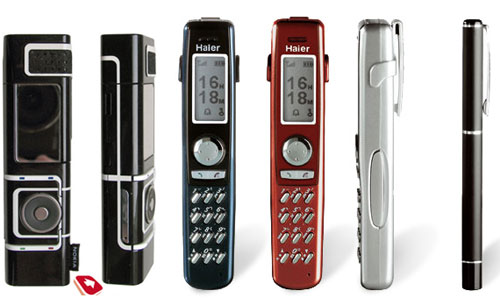
Nokia has intended the model for a fashion segment from the beginning and that is the reason of those various materials that are used in the device. First, the screen is mirror-like and it may be used as a real mirror in the standby mode. Second, the loudspeaker gap is protected with a chamois insertion and is firmly integrated into the body. The same chamois insertion is on the right-side surface of the device and here it's necessary for sliding the device into a camera mode. An evident minus of the chamois insertions is they are easily soiled, dust and dirt from a lady's handbag are seen on them. They may be cleaned with a special brush for such surfaces and many of those who wear chamois clothes do surely have this thing. Third, a small tag with the manufacturer's name may be seen on the right surface. That is a complete copy of similar labels of famous clothes brands and that gives some similarity with a fashion accessory to the device.

The only one colour solution represented is black glossy plastic and fingerprints do stay on it. A cloth is not included into a package but a case of soft leather fully replaces it. The case is red inside and if carrying the device in the case the number of grease stains surprisingly decreases. The accessory is really stylish and matches the whole device greatly. There is a white edging on the top end of Nokia 7280 and a red LED is hidden behind it. In the standby mode it turns on smoothly lighting the top end in a circle that looks stylishly. This indication also works to alert various events. The device put in the case is seen anyway and then an edge of the inner part of the case and a top of the device. An interesting hint appears when the red edge of the case calls up with the lighting.


The accessories included into the package are worth telling about separately. And now I'd like to note only there is a strap that is fixed to a staple on the bottom end of the device. The strap is made in the same key like the case and has a silvery insertion besides.
Let's go back to the screen of the device. It has a specific position due to a specific form of the phone. The screen is placed horizontally (top-down). That means to work comfortably you'll need to hold the device not vertically but horizontally. Considering the fact the phone weights 84 grams you'll find no problems using it this way. The total size of the model is 115x32x19 mm and it perfectly fits a lady's handbag or a pocket. Though it seems a sin to hide it from the others' eyes and the device is probably better to hang on your neck.

The resolution of the 65K TFT screen is 104x208 pixels (16x30 mm). When displaying an SMS the screen shows up to 4 text lines and one service line (a headline). Due to the position of the screen all the tips for soft keys are placed in the right vertical column. The quality of the screen is not bad and the colours are bright and vivid. The preset pictures are not bad and show the screen possibilities well. In the sun it behaves well much better than other Nokia screens similar in characteristics. The reason seems to be in the mirror like cover.

An obvious difference from other models is not only in the screen possibilities but in a complete absence of any keypad. Only two soft keys are seen under the screen a control element resembling a loudspeaker is a bit lower and two buttons to call and end call are under it. Saying a control element we mean a usual Navy Wheel that came to the model from the automodels in particular Nokia 810. The wheel helps to move along the menu, enter text and perform some other operations that are characteristic for a keypad in traditional phones.
The wheel may be turned in the horizontal line in two directions, a black insertion of rubber prevents a finger from slipping. The wheel is comfortable to work with a thumb of any hand you like. The OK button is integrated into the wheel. A white backlighting shines around the wheel and that makes a great visual effect.

On the left-side surface you can see a polyphonic alert gap that is the second loudspeaker. An IrDA gap is a bit lower and it is almost not seen. A silvery piece of the body is seen under and here is a SIM-card holder. A special metallic stick is included into the package. That is necessary to insert into a special gap for opening the module. Also it may be opened with any sharp device like a pin or a paper clip. A standard package contains the second SIM-card holder, evidently the manufacturers considered a user might loose the one preset when the device fell.

The device is impossible to disassemble except for a changeable panel near the camera that is enough to slide the device apart and pull the panel. There is a bar-code sticker on the top and a usual user has nothing interesting to see here (there is nothing to clean here when using an accumulator). And looking on the red LED is also makes no great interest.


There is a microphone gap, a headset and a charger connector on the bottom end. A user has no access to the battery integrated into the phone. The battery is 700 mAh BL-8N. And according to the manufacturer it works for 240 hours in the standby mode and up to 3 hours in the talk mode. In Moscow the device worked for about 2 days in case of 90 minutes of talks and minimum of other functions. Longer working time was achieved when decreasing the talk time to 60 minutes (3 days). Using the bluetooth actively tells upon the working time not greatly, that would be two days without working at night. Comparing the device with standard Nokia phones in the working time I had a felling the battery has less capacity since there are no evident reasons for high energy consumption. Turning the LED off increases the working time for about 3 hours and that is not critical. Full recharging takes about 1 hour 10 minutes.
I'd like to note the charger included into the package is very qualitative and the wire is hidden behind rubber insertions and the charger matches the device in style.
The only thing left to tell about is the device may slide apart (do you remember a chamois side insertion?). A VGA-camera lens is seen on the back panel then unfortunately the device doesn't turn the camera interface automatically on opening (that would be logical and there is something similar in Nokia 6650). The device may be opened with one hand but that will take some effort. When the device is used actively the chamois insertion comes unstuck. Girls will find it easier to open the device with two hands. At the incoming call opening the device means answering on the call and closing it will end the call. In principle the mechanism is like an active flip or a slider in behaviour (and the device is actually a sort of a slider).


Menu
Let's turn the phone horizontally and activate the screen (press any key) in the standby mode. The name of the operator is displayed on the screen; three tips (two for soft keys use and the middle one for an OK button integrated into the Navi selector) are placed vertically.
 
Entering the menu is possible by pressing the Ok button, an Active menu with the most frequently used functions is separated and a user may adjust for his needs.

Pressing the Ok button for long calls dialing a number and let's learn how to work with the device at this example. Numbers and characters that may be used when dialing are displayed in the bottom line. Scrolling the selector you choose a necessary button and then press Ok, the number appears on the top. The operation is repeated for every number of the phone number and then you press the Call button and thus start dialing. The list of numbers may be scrolled in both directions. You may turn a cyclic recurrence off and then at reaching the final character the scroll is stopped and you'll have to go back. The setting works for letter input also.
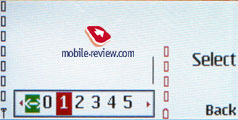
Entering a number with Nokia7280 is a durable process and it's at least two-three times longer than for usual phones. The device is not very ergonomic in this parameter. I'd recommend to all the fashionable women to enter the contacts to the phone book first (that's better to do via a PC) and then searching for a contact and calling it will take less time. Call lists remained standard, each one contains up to 20 entries and time and date are shown for an entry. If pressing the Call button in the standby mode you'll see a last dialed numbers list.

The menu looks standard (an animated icon with a tip for it, only one menu style), that's curious a number corresponds with every menu item and that is probably a vestige of a standard platform. In a usual phone numbers may be used for speed calling this or that function and here the numbers seem senseless.
 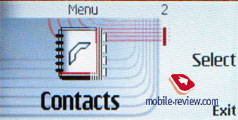
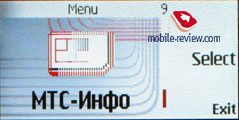 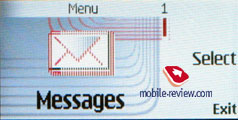
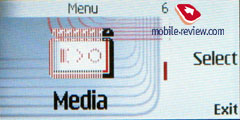 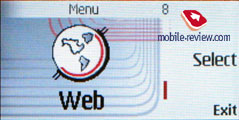
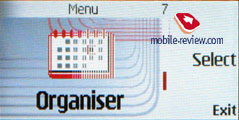 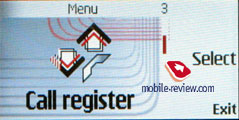
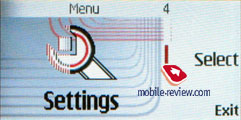
Entering text is similar to dialing a number and the only difference is that alphabet is scrolled. Nokia has foreseen a system guessing words, in some kind that's like T9. You start entering a word and enter the first letter and the list provides the most possible following letters for you to choose (the letters are indicated in blue). This system makes life easier but slightly. If you made a mistake you'll have to enter editing mode (a cursor) and leave it by one Ok button press. Comparing the way text is entered here with standard phones I'd like to say it is slow due to the absence of a keypad and using a circle selector is not a cure. And often entering 70 characters of SMS take about several minutes, that is long.
 
Phone book. This is a standard 40-platform phone book. Up to 100 names may be saved in the internal memory (that is an average number when the fields are filled in maximum, the memory is dynamical). Up to 5 numbers for a name, select its type (main, mobile, home, work and fax). The first entered number is a default one and then after you'll be able to change it by your wish. When entering for the first time you can have only a name and one main number and all the other actions are possible later from the editing menu. One will find this not convenient and others will say they keep only one number for a name. Both will be right. Considering the fact the same input type is realized in all the phones by Nokia we can surely say it makes no problems.
 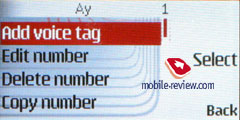

E-mail address, site URL, post address and a text note may be saved as extra information for a name.
A photo may be added for a name (only portrait mode or changing the photo to fit a necessary size automatically). When viewing info for a name you won't a photo automatically you'll have to open a corresponding item. On the other hand viewing a name and a corresponding image may be set in a general list. An icon is small in this mode and gives a little impression of a picture. Other ways of representing the list are traditional - only names, names with main number. The general list may represent both numbers from the internal memory and from the SIM-card one.
Up to 10 voice tags may be assigned to names. The function works stable even in the street.
A total number of 100 photos may be assigned to names. Caller's number and a corresponding photo are displayed during the call. The picture is a bit bigger than in a list but still smaller than necessary. You'll have to use you imagination to understand who is on the picture because when decreasing the photo you get extra distortions. In general the photo takes a very small part of the screen and this is unexplainable logically. The realization of this function is the weakest in the phones by Nokia for the moment, let's hope the changes will come in the future.

There are only 5 users' groups in the phone and that is not typical for Nokia devices. A melody may be assigned for each group. Considering the general comfort of the phone book we can call it average. On the one hand there are many fields and on the other hand input is adapted more for working with a PC but not he phone itself. I'd like to stress the phone book is typical for Nokia's phones. There are no any principal changes (read improvements). Siemens phones are the richest in functions of a phone book, then Sony Ericsson follows and Nokia after it.
Messages. The device has a support for Nokia Smart Messaging and that allows sending and receiving melodies and plain black and white pictures from compatible devices. Phones by Samsung, LG and some new devices by Motorola support the standard besides Nokia. Up to 10 graphical templates are preset for such messages and emotion icons may be added to the messages. Unfortunately the company standard limits the users because an alternative EMS standard is spread wider today and allows not only send and receive melodies and pictures but also format texts. The prevalence of the standard is maximum for European countries and the fact Nokia ignores it may e considered a real drawback. In Russia only the main operators do support the standard and the presence or absence of the support in regions is not critical. The fact may be disputable but the absence of support for EMS is a minus for Nokia's phones.

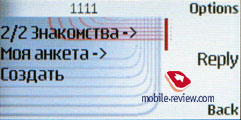
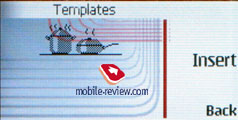
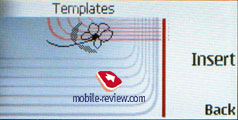

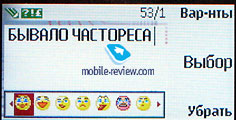
The company thinks that MMS may be a fully functional substitute for EMS. And really, the technology gets everyday and even more interesting messages containing photos, color images, melodies and so on may be created with its help. Every message may be up to 100 KB in size. The realization of MMS is well done in the device and there are no any problems.
Settings. Profiles may be activated from a corresponding menu. Each profile may be activated temporary for a period of time and then the phone switches the default one. Sound signals may be adjusted for all the events, the incoming call signal for all the calls or for special users' groups. The realization of the profiles in Nokia phones is one of the best in the market.
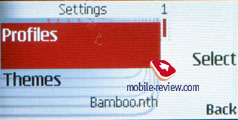

Screen settings allow choosing its color scheme, wallpapers and a screen saver. A screensaver is a picture displayed in the standby mode with the backlighting off. One of the preset pictures should be selected as a screen saver because they are seen better in this mode than full colour pictures.


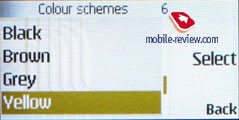
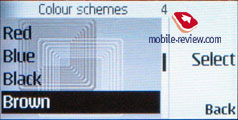
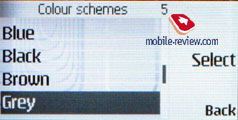
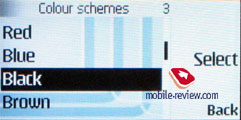

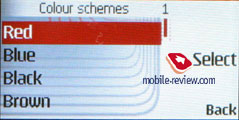
There are themes that change all the settings in no time. Total and free memory size may be viewed from the settings menu (up to 52.4 MB of memory).

A possibility to switch an improved sound during a conversation should be mentioned. That is a sort of an equalizer changing the sound in noisy rooms according to the preinstalled on the factory settings. A similar function is mass integrated in Samsung phones now and there it is called Voice Clarity.
There is a key lock in the phone (but is it necessary?) you also can use a special security code for nobody could use your phone. A possibility to set the behavior of the phone from the beginning appeared, for instance, you may choose a profile that is activated when the headset or a charger are plugged in. That is an interesting possibility that allows setting the phone according to your idea of a necessity.
Gallery. Here all the folders that contain different files are gathered, they have corresponding names. There is a possibility to view the folders as a list, a list with names or icons. You always may create your own folders, sort files.


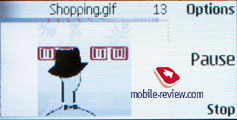
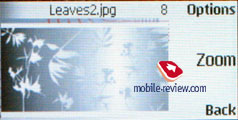
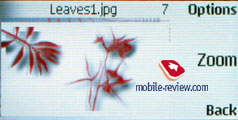
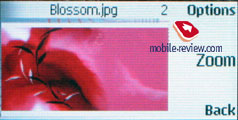
Media. In this part all the settings connected with multimedia capabilities of the device are gathered, let's start considering them from the Camera. The integrated camera allows to take photos with VGA resolution and in the portrait mode. (80x96 pixels). The quality of the pictures on the screen is average. After transmitting them on a PC they do not get worse but still not very good. The settings of the camera are ascetic, there is a night shooting mode, three types of quality and compression levels. The files are stored as JPG. The quality of the camera is lower than average and maybe the size of the device told upon. The phone doesn't record video.


- Photo sample, VGA, JPEG
- Photo sample, VGA, JPEG
- Photo sample, VGA, JPEG
- Photo sample, VGA, JPEG
- Photo sample, VGA, JPEG
A dictaphone allows to record up to 3 minutes of speech and works during the conversation. The number of entries is limited only by the free space in the memory.

Media player is a simplified player for musical files. That means you open a file and may listen to it either via earphones or using a speakerphone. There are no track lists, equalizer settings are placed into a separate menu item and are used for all the musical applications. The media player doesn't show the names of the mp3 files and that is a disadvantage. Using a model as an mp3 player is impossible when having no memory card and internal 50 MB of memory are for call melodies files, photos and that's all.

Radio. The device allows saving up to 20 FM-stations and set text names for them. The function is similar to other devices by Nokia. Unfortunately, switching via the saved radio stations using a button on the headset is impossible. The radio may work in the loudspeaker mode but attaching the headset is necessary since it services as an antenna. Radio signal also may serve as an alarm signal but the headset is necessary again.

A stereo headset is included into a package. It is comfortable to wear due to the catches that circle the headset into a necklace. A wire has a plastic braid, if the radio doesn't work, you carry a headset and the wires touch each other a strange noise of the braid rubbing appears. In general the headset is acceptable but in the turned off mode the wires are so long that get tangled.

Organizer. You may keep from 100 to 250 entries in the memory and everything depends on their length, there is an automatic erasing of the old entries (by the time characteristic). There is a month and week view of the calendar, the last view has a division into hours, there is a quick switch to an entered date. There is a possibility to enter up to 5 different events (meeting, call, birthday, reminder, memo). A notification may be assigned to an event, they may be recurrent.
 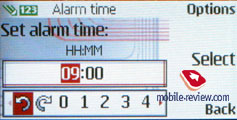 A to-do list allows to create events with three priorities (high, normal and low), and set a critical date for every event.
 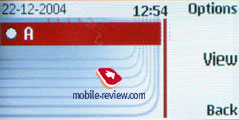 Notes. Every note may contain up to 3000 characters, in general it is more than enough even for the most fastidious user. Two different font sizes are supported like in messages.
An alarm clock allows to set both once or recurrent signal.
Synchronization. SyncML settings are here.
Internet. Wap-browser is version 2 and allows viewing xHTML pages. There is nothing special to say about it.
Synchronization with PC. The disk with software has a special cover designed for this model and it matches the device. That is another proof the manufacturers came very seriously to the point of adjusting the device.
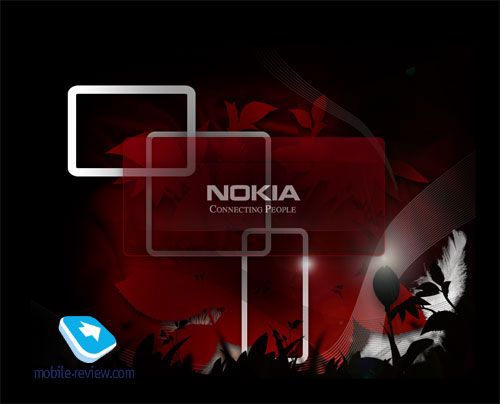

A standard Nokia PC Suit is used for synchronization. There is nothing special to say about his program, there is a complete synchronization with MS Outlook and some other popular programs.
Bluetooth, IrDA. The advantage is an IrDA is fully functional and allows transmitting all the supported file formats from one phone to another and also the device may be used a GPRS/EDGE modem.
The device supports almost all the Bluetooth profiles including Dial-Up Networking, Headset, Handsfree, Obex Object Push, Obex File Transfer, Audio Gateway, File Transfer Protocol. There are no cavils roused by Bluetooth work in the majority of cases, though sometimes similar to Nokia 6230 symptoms were noticed (connection was lost when transmitting big files about 20 MB in size). Problems characteristic for Nokia PC Suite version 6.3 may appear when using standard software for synchronization. I'd recommend using a previous version of the suit.
Impressions
Sound possibilities of Nokia 7280 come from the same hardware platform as used in Nokia 6230. The volume of the loudspeaker is enough in the majority of cases and a possibility to use an extra mode called equalizer adds to its quality. Standard polyphonic alerts sound low and are heard badly that is characteristic for Nokia models. Especially for Nokia 7280 a set of AAC signals was added. Some of the sounds have voices and some imitate various situations like flight announcement. These signals were first used in Sony Ericsson, in particular that was Sony Ericsson P900. A melody sample really proves the model was though over well. The volume of mp3 or AAC melodies is not bad though the call is heard not always from the lady's handbag. The ideal place for the device is on the neck. The power of the vibrating alert is low.


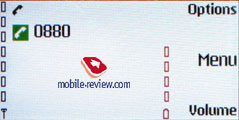
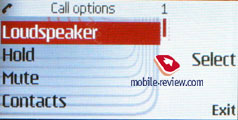
The model rouses no cavils in the quality of connection. Evaluating the device from the fashion point of view we may surely say that's an ideal solution for a target group. On the one hand the model has an attractive appearance, is unordinary and has new functions, on the other hand the price is high and will decrease slightly with time.
The absence of a usual keypad is a disadvantage and the result is low speed of entering numbers and working with texts. That is partly liven down working with the phone book or when the number of incoming calls is much more than outgoing ones. The device is ideal as a second phone for a woman, but it won't be suitable for active work or those who consider themselves a business lady.
The price is about 550-600 USD now. But it won't fall under 540 USD for a current moment. Later the device will decrease in price but not significantly. The device has no copies due to its original design and control possibilities. Considering the popularity of Nokia brand we can speak about the prestigiousness of the device. That is the best offer for young girls having a glamour life style.
The SAR value for the device is 0.82 W/kg.
Melody samples (mp3, 346 KB)>>>
Links on the topic:
Eldar Murtazin (eldar@mobile-review.com)
Translated by Maria Mitina (maria.mitina@mobile-review.com)
Published — 23 January 2005
Have something to add?! Write us... eldar@mobile-review.com
|










































































